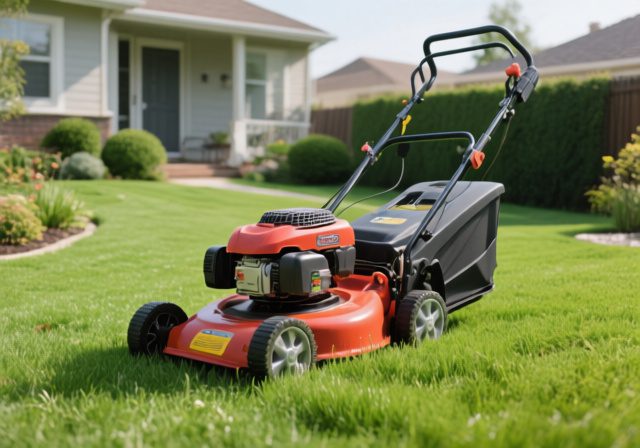

When I invested in my first lawn mower, the salesperson promised it would last “forever with proper care.” Three years and countless repairs later, I learned that lawn mower lifespans depend on much more than just maintenance. After researching industry data and talking with equipment dealers, I discovered that most homeowners can expect their mowers to last 8-10 years with average use, though this varies significantly based on the type of mower and how you care for it.
The real answer isn’t measured in years alone. Professional landscapers and equipment manufacturers measure mower lifespans in operating hours, similar to how we track vehicle mileage. A residential mower typically operates 30-50 hours per year, while commercial models might run 500-1000 hours annually. Understanding these numbers helps you make smarter purchasing decisions and plan for eventual replacement.
Different mower types have vastly different lifespans, and choosing the right one can save you thousands over the years. Here’s what you can realistically expect from each type based on manufacturer data and industry testing.
Traditional gas push mowers remain the most common choice for homeowners, lasting 450-500 hours for budget models and up to 1,000 hours for premium brands. At average residential use of 35 hours per year, that translates to 7-10 years for standard models and potentially 15+ years for high-end options. The engine typically outlasts other components, with proper maintenance extending operational life significantly.
Electric mowers offer compelling longevity benefits with fewer moving parts to maintain. Corded electric models can run 10-15 years with minimal maintenance since they lack engines that require oil changes or spark plug replacements. Battery-powered mowers present a different equation – while the mower itself might last 10 years, batteries typically need replacement every 3-5 years at $150-300 each. However, these energy-efficient appliances produce zero direct emissions and require less annual maintenance.
Riding mowers represent a significant investment but offer proportional durability. Entry-level riders last 500-700 hours, while commercial-grade zero-turn mowers can exceed 2,000 hours with proper care. For homeowners with large properties mowing 2-3 hours weekly during the season, a quality riding mower should provide 8-12 years of service. Commercial landscapers might replace equipment every 3-5 years due to intensive use.
The newest category in lawn care, robotic mowers typically operate 5-7 years before major component replacement. Since they run almost daily during the growing season, they accumulate hours quickly but use smaller, more efficient motors designed for continuous operation. Battery replacement costs mirror those of cordless push mowers.
Understanding what impacts mower longevity helps you maximize your investment and recognize when problems develop beyond normal wear.
Regular maintenance can double your mower’s lifespan. I track every oil change, blade sharpening, and filter replacement in a simple notebook. Gas mowers need oil changes every 25-50 hours, air filter cleaning every 25 hours, and spark plug replacement annually. Electric mowers require less frequent attention but still need blade maintenance and deck cleaning. Neglecting these basics can reduce lifespan by 50% or more.
Where you store your mower matters more than most people realize. Mowers left outside deteriorate rapidly from moisture exposure, temperature fluctuations, and UV damage. A dry garage or shed adds years to equipment life. During winter storage, I run the engine dry or add fuel stabilizer, remove the battery from electric models, and coat metal surfaces with light oil to prevent rust.
Mowing frequency, grass type, and terrain significantly impact wear rates. Weekly mowing on level ground creates minimal stress, while cutting tall, wet grass on slopes accelerates component wear. Sandy or dusty conditions clog air filters faster, requiring more frequent maintenance. Properties with hidden rocks or roots cause blade damage and stress transmission components.
Budget mowers use thinner steel decks, plastic components, and less powerful engines that wear faster under stress. Premium models feature reinforced decks, sealed bearings, and commercial-grade engines designed for extended operation. The price difference often reflects genuine durability improvements that pay off over time.
Knowing when to repair versus replace saves money and prevents dangerous equipment failures. Watch for these definitive warning signs that indicate your mower’s approaching end of life.
Consistent starting problems, excessive smoke, power loss, or unusual noises signal major engine wear. When repairs exceed 50% of replacement cost, it’s time to upgrade. Compression testing can definitively diagnose engine condition – readings below manufacturer specifications indicate significant internal wear.
Deck cracks, bent frames, or broken height adjustment mechanisms compromise safety and cutting quality. While minor deck holes can be patched, extensive rust or multiple cracks warrant replacement. Check mounting points for engine and wheels – stress cracks here pose serious safety risks.
When you’re fixing something every month, replacement becomes economical. Track repair costs over time – if annual maintenance exceeds $200-300 for a push mower or $500+ for a rider, consider upgrading to newer, more reliable equipment.
Proper maintenance extends mower life while improving performance and reducing emissions. Here’s my tested maintenance schedule that’s kept my current mower running strong for eight years.
| Task | Frequency | Time Required | Cost |
|---|---|---|---|
| Check oil level | Before each use | 1 minute | Free |
| Clean deck and blade | After each use | 5 minutes | Free |
| Change oil | Every 25-50 hours | 15 minutes | $5-10 |
| Clean/replace air filter | Every 25 hours | 5 minutes | $10-20 |
| Sharpen blade | Every 20-25 hours | 20 minutes | DIY or $15-25 |
| Replace spark plug | Annually | 10 minutes | $5-10 |
| Winterize engine | End of season | 30 minutes | $10-15 |
While I handle basic maintenance myself, professional service every 2-3 years catches developing problems early. Technicians check valve clearances, test compression, inspect safety systems, and identify wear patterns you might miss. This $100-150 investment often prevents major failures.
Modern mower choices significantly impact both your wallet and the environment. According to EPA data, gas-powered mowers produce as much pollution in one hour as driving a car 300 miles. Making eco-friendly choices when purchasing and maintaining lawn equipment reduces your carbon footprint while often saving money long-term.
Electric mowers eliminate direct emissions and reduce noise pollution by 75%. While battery production has environmental costs, the lifecycle emissions remain lower than gas alternatives. When your gas mower reaches end-of-life, consider electric options that now match gas mower performance for most residential properties.
Proper disposal matters too. Old mowers contain recyclable steel, aluminum, and plastic worth $20-50 at scrap yards. Many communities offer special collection events for lawn equipment, ensuring proper fluid disposal and material recovery. Learn about the complete recycling process to responsibly dispose of your old equipment.
Making smart financial decisions requires understanding total ownership costs beyond purchase price. Here’s my analysis based on real maintenance records and current market prices.
A $300 gas push mower lasting 10 years costs approximately $30 annually in depreciation, plus $50-100 in yearly maintenance, totaling $80-130 per year. A $600 electric mower with similar lifespan costs $60 in depreciation, $20-50 in maintenance, plus $50 for battery replacement every 4 years, averaging $92-122 annually. Despite higher upfront costs, electric mowers often prove economical through reduced maintenance.
For repairs, follow the 50% rule: if repair costs exceed half the price of a comparable new mower, replacement makes more sense. A $150 engine rebuild on a 7-year-old $300 mower might seem reasonable, but consider that other components likely need attention soon. That same $150 could go toward a new mower with warranty protection and improved efficiency.
Quality residential mowers typically last 450-1,000 hours depending on build quality and maintenance. Budget models average 450-500 hours, while premium residential mowers can exceed 1,000 hours with proper care. At 35 hours annual use, expect 7-15 years of service.
Electric mowers often outlast gas models due to fewer moving parts and no engine maintenance requirements. The mower itself can last 10-15 years, though battery replacement every 3-5 years adds cost. Overall lifecycle costs remain competitive with gas alternatives.
Change oil every 25 hours for new mowers during the first season, then every 50 hours thereafter. Dusty conditions or heavy use warrant more frequent changes. Check oil before each use and top off as needed – running low on oil causes immediate engine damage.
Most owners can handle oil changes, air filter cleaning, blade sharpening, spark plug replacement, and deck cleaning with basic tools. Leave valve adjustments, carburetor rebuilds, and transmission repairs to professionals unless you have mechanical experience.
Follow the manufacturer’s maintenance schedule religiously, store equipment in a dry location, clean the deck after each use, avoid mowing wet grass, and address problems promptly before they worsen. These simple practices can double your mower’s lifespan.
Your lawn mower represents a significant investment in property maintenance, and understanding lifespan expectations helps you plan and budget effectively. Most residential mowers provide 8-10 years of reliable service with proper care, though this varies based on type, quality, and maintenance.
When evaluating your current mower, consider repair costs, reliability trends, and technological improvements in newer models. Today’s mowers offer better fuel efficiency, reduced emissions, and improved safety features that might justify upgrading even if your current model still runs.
Remember that the cheapest mower isn’t always the most economical long-term. Investing in quality equipment and maintaining it properly delivers the best value while reducing environmental impact through extended equipment life and improved efficiency. Whether you choose gas, electric, or battery power, proper care and timely replacement ensure your lawn stays pristine while minimizing cost and environmental impact.

Don't let aphids, slugs, and caterpillars ruin another plant. Take back control with simple, natural methods that actually work.